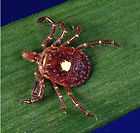Prostigmata
| Prostigmata | |
|---|---|
| Scientific classification | |
| Kingdom: | Animalia |
| Phylum: | Arthropoda |
| Class: | Arachnida |
| Subclass: | Acari |
| Superorder: | Acariformes |
| Order: | Trombidiformes |
| Suborder: | Prostigmata |
| Supercohorts | |
| |
The Prostigmata is a suborder of mites belonging to the order Trombidiformes, which contains the "sucking" members of the "true mites" (Acariformes).
Many species are notorious pests on plants. Well-known examples of prostigmatan plant parasites are species of the gall mites (Eriophyidae, e.g. the redberry mite Acalitus essigi), Tarsonemidae (e.g. the cyclamen mite, Steneotarsonemus pallidus), and the spider mites of the Tetranychidae (e.g. the two-spotted spider mite, Tetranychus urticae).
Other Prostigmata live as parasites on vertebrates (e.g. Demodex mites of the Demodicidae) or invertebrates (e.g. Polydiscia deuterosminthurus of the Tanaupodidae or the honeybee tracheal mite, Acarapis woodi, of the Tarsonemidae). There are also some forms (e.g. Smarididae) that are predators of small invertebrates – including smaller Prostigmata – yet others have a more varied lifestyle (e.g. Tydeidae) or switch their food sources as they mature (e.g. Erythraeidae). The suborder also include the family Halacaridae (marine mites).[1]
Some of the Prostigmata parasitizing vertebrates are of medical relevance due to causing skin diseases in humans. These include for example harvest mites ("chiggers") of the Trombiculidae.
Systematics and taxonomy
The Prostigmata make up the bulk of the acariform clade Trombidiformes, which also contains the minor and quite ancient lineage Sphaerolichida. The trombidiform mites are possibly the most promising approach to untangle the systematics, taxonomy and phylogeny of the notoriously complex Acariformes. Trombidiformes and the other acariform clade, Sarcoptiformes, were formerly considered suborders but this does not allow for a sufficiently precise classification of the mites and is adjusted in more modern treatments.[2]
They contain a few of the little-known "Endeostigmata" – apparently an assemblage of several specialized but unrelated lineages – which for the most part appear to be Sarcoptiformes however.[2] In addition, the Trombidiformes include the bulk of the presumed group of mites called "Actinedida". This taxon is still commonly encountered in systematic treatments. However, modern cladistic studies time and again fail to find any monophyletic group corresponding to the "Actinedida". Thus, they appear to be an evolutionary grade rather than an evolutionary lineage, united not by their apomorphies but by the lack of such characters that have evolved after the Acariformes separated from the Parasitiformes. Thus, the "Actinedida" seem to be a massively paraphyletic "wastebin taxon", uniting all Acariformes that are not "typical" Oribatida and Astigmata.[2][3]
The Prostigmata present their own taxonomic and systematic problems even in the redefined monophyletic delimitation. They are variously subdivided into the Anystina and Eleutherengona, and Eupodina. The delimitation and interrelationships of these groups are entirely unclear; while most analyses find one of the latter two but not the other to be a subgroup of the Anystina, neither of these mutually contradicting hypotheses is very robust; possibly this is a simple error because phylogenetic software usually fails in handling non-dichotomous phylogenies. Consequently it may be best for the time being to consider each of the three main prostigmatan lineages to be equally distinct from the other two, not including either Eleutherengona or Eupodina in the Anystina in accord with the traditional view – the suborder Anystina are here considered the largest possible clade containing the Anystidae but no taxon assigned to the other two suborders.[3]
Anystides
Section Parasitengona
- Superfamily Amphotrombioidea
- Superfamily Arrenuroidea
- Superfamily Calyptostomatoidea
- Superfamily Erythreoidea
- Superfamily Eylaoidea
- Superfamily Hydrachnoidea
- Superfamily Hydrovolzioidea
- Superfamily Hydryphantoidea
- Superfamily Hygrobatoidea
- Superfamily Lebertioidea
- Superfamily Stygothrombioidea
- Superfamily Trombidioidea (possibly paraphyletic)
Section Anystae (possibly paraphyletic)
- Superfamily Anystoidea
- Superfamily Caeculoidea
- Superfamily Paratydeoidea
- Superfamily Pomerantzioidea
- Superfamily Pterygosomatoidea
Eleutherengonides
Family incertae sedis Paratydeidae
Section Heterostigmata
- Family incertae sedis Athyreacaridae
- Family incertae sedis Crotalomorphidae
- Family incertae sedis Fembidiacaridae
- Superfamily Heterocheyloidea
- Superfamily Pyemotoidea
- Superfamily Pygmephoroidea
- Superfamily Tarsocheyloidea
- Superfamily Tarsonemoidea
Section Raphignathae
- Superfamily Cheyletoidea
- Superfamily Pomerantzioidea (disputed)
- Superfamily Pterygosomatoidea (disputed)
- Superfamily Raphignathoidea
- Superfamily Tetranychoidea
Eupodides
- Superfamily Bdelloidea
- Superfamily Eupodoidea
- Superfamily Eriophyoidea
- Superfamily Halacaroidea
- Superfamily Labidostommatoidea
- Superfamily Tydeoidea
References
- ↑ Halacaridae: Marine mites
- ↑ 2.0 2.1 2.2 Heather Proctor (August 9, 1998). "Acariformes. The "mite-like" mites". Tree of Life Web Project. Retrieved December 30, 2007.
- ↑ 3.0 3.1 Heather Proctor (August 9, 1998). "Trombidiformes. Trombidiform mites". Tree of Life Web Project. Retrieved December 30, 2007.
| ||||||||||||||||||||||||||||||||||
